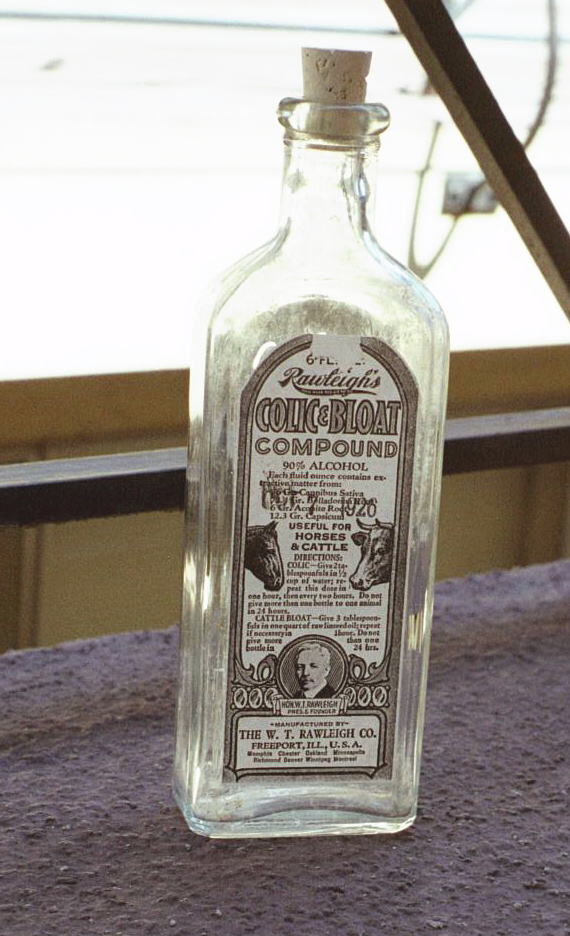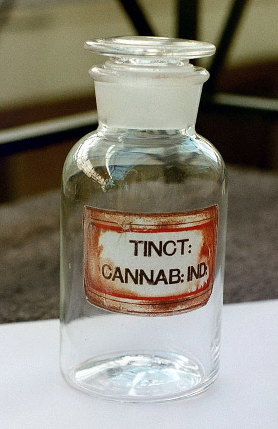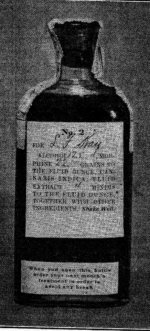ANTIQUE CANNABIS
OF FORGERIES AND REPRODUCTIONS
(What The Antique Collector Should Know)

WOULD YOU BUY THIS CANNABIS BOTTLE FROM A TOTAL STRANGER?
I WOULDN'T, ----- IT'S A TOTAL FAKE
Asked about a lovely oil painting that turned out to be a fake, a Frenchman once replied:
"An old painting, or a work of art . . . they are like unto a love affair. No matter the beauty or how wonderful it may have been, when one discovers that the lover is not true . . . it is all over."One can only assume that same could be said of an antique Cannabis bottle. No matter how beautiful it may look, no matter what value it may once have had, once it is revealed as a forgery the beauty (not to mention most of its monetary value) is all gone. And I for one can not overstate that all the enjoyment such an antique can possible give you will also be gone, replaced only by a foolish grin.
2.1 - OF FORGERIES AND REPRODUCTIONS:
"If there's a market for something --- If someone is willing to pay for it. Then let the law be damned --- That demand is going to be filled."----Quote attributed to Al Capone.There's a great deal of wisdom that can be attributed to that quotation, which while attributed to the notorious Chicago underworld chieftain Al Capone, may as well have come to us from the head of the Federal Reserve. For given a demand (for anything), some entrepreneur will always come along and fill that demand, even if (as in the case of antiques), they have to manufacture their own products to do so.
This then is why it is most important for the antique dealer, as well as the collector, to have an instinctive knowledge of Cannabis, its time lines and associated uses. This, I have found, second only to knowing the actual history of the object in question, is the key to protecting oneself against the possibility of forgeries. Knowledge, after all, truly is power.
2.2 - A PERSONAL STORY:
Some time back, I was supposed to speak to a small group of -- I'll call them -- collectors who were interested in the subject of Cannabis medicines. I thought my presentation would be a bit better if I brought some samples, actual bottles that I could pass around and show. Unfortunately, due to logistical problems (meaning a lack of money), I didn't have any at the time. So I did the next best thing: I simply took some old Cannabis medicine labels that I had down to a photocopy shop, made color photocopies of them, and glued them on a bunch of old-looking bottles. I meant to use them only to demonstrate what the actual bottles would have looked like, and thought for sure that no one would ever think they were for real.
To my horror (and these were people who should have known better) even before my talk was over, I was being offered some very big bucks for them. I was very much in a state of shock as to how easy it could be to fool people.
Of course, I told everyone what I had done, and we all had a good laugh about it. And some of them still wanted to buy the bottles, but the prices had now dropped substantially, from hundreds of dollars to less than what I had spent making them in the first place.
In any case, it was at this time that I began to wonder: If one had larceny in one's heart, how easy would it be to fool an antique buyer? If the above example is any indication, very easy, it was almost as if they are begging to be ripped off. People, either because of today's political climate or because of personal medical needs, really want to believe. And as you will see in this book, making one's own reproductions is extremely easy. Thus, again, the need for the collector to have an instinctive knowledge of Cannabis, and its historical uses, if solely to protect oneself from the less than reputable elements. [Note the above bottle was one of those items mentioned]
2.3 - PROVING AUTHENTICITY -- SEVERAL RULES OF THUMB:
2.3.1 - PROOF BY THE AGING FACTORS:
This is a rough one because it is so easy to falsify or reproduce the effects of aging. However, it still is one of the factors that should/must be looked at, and yes it does provide some level of assurance.

Let's take a look at the fake apothcary jar above [See Better Pictures]. Note how clean and new looking the glass looks. To me it looks like it could have been made just yesterday, and in all likelihood it was.
The same statements could also be said of the label, (paper looks too new, ink still wet, etc.) and numerous other factors. But again, WARNING, it is very possible and in fact very easy to artificially create the appearance of age.
2.3.2 - PROOF BY SURROUNDING ELEMENTS:
This one may take a bit of explanation; maybe a couple of examples would be of help.
Sometime back, I noted that a particular antique dealer kept offering Cannabis antiques for sale, one after the other. Suspicious as to their authenticity I wrote him a note inquiring as to where he was obtaining them. Needless to say, I received no reply and I quickly put him on my blacklist. --- Hey, let's be realistic, there are only so many Cannabis antiques out there, so where was he getting them? I feel the answer was obvious.
On the other hand, at about the same time, I noted that there was yet another antique dealer who also was selling a lot of Cannabis antiques. However in this case, I also noted that she was not only selling Cannabis antiques, but also a lot of other medical antiques from the same era. In addition, in reply to my inquiry, she told me that she obtained her sales items via estates and old drugstore liquidations etc. In other words, everything made sense; all the surrounding elements were there.
Allow me give yet one more example. Talking to a dealer about some old written Cannabis prescriptions from the 1910's, I asked where she had obtained them. She told me that she had just bought a whole box [originally from an old drugstore] full of them.
Examining the box, I noted that, in addition to the Cannabis, opium, morphine etc., valuable ones, there were also numerous other written prescriptions for the more mundane ones that held little interest and had virtually no financial value. This was a good sign, [the surrounding elements were all their], and in addition all the surrounding elements also looked aged, and held many similar characteristics.
Once more, prescriptions are very easy to fake. Anyone with access to old yellowish paper can easily put one together. And as doctors seem to universally have bad handwriting, you don't even have to be very good at it. However be that as it may, why would anyone want to forge so many fake prescriptions with virtually no financial value. Prescriptions for Cannabis, Opium, Cocaine etc., have some value (between $10 and $20 each) but most antique prescriptions (say for camphor) sell for less than $1 each. Therefore (in the given case) were these prescripts total forgeries, the surrounding elements simply would NOT be there.
2.3.3 - PROOF VIA THE APOTHECARY UNITS:
Given the ease, with which old paper labels can be obtained (either originals from old pharmaceutical books or modern day reproductions), as well as the readably availability of old bottles from the era. A basic knowledge of the old apothecary units is becoming indispensable. Example: How big should a bottle be if it contains 100 tablets (of 5 grains each)? I, for one, don't know. But I definitely would be suspicious if the bottle were more then 4" inches in height. [See Basic Units]
|
In general, apothecary units are no longer in use, either by pharmaceutical manufactures or druggists. However, given their historical usage (just about all antique cannabis bottles made use of them), it becomes imperative for any serious antique collector to have at the least, a basic understanding of them. Below is a set of my own (very unscientific), more or less, definitions. The idea is to give the reader an instinctive (as opposed to a PhD gobble-goop) understanding.
|
One cannot underestimate the importance of learning, at least the basics, of Apothecary Units. If you're going to be a collector, you will have to learn them.
2.3.4 - PROOF BY TIME LINE:
Although Cannabis has been in medical use for centuries, (actually thousands upon thousands of years), not all of its uses were apparent at first. For instance, it wasn't until after 1840 that western medical doctors began to use Cannabis to ease the symptoms of tetanus. I would therefore become very suspicious of anyone who attempts to sell me an old Cannabis antique treatment for tetanus (supposable) from the 1930's (and believe me, that one has been tried).
It therefore becomes obvious that a good knowledge of Medical Cannabis and its Medical time line is in order. Fortunately for the reader, one of the chapters of this book is devoted to that subject and several other sections [such as appendix B] can also provide useful information.
2.3.5 - PROOF BY TRIVIA (aka Knowledge is Power):
It's good to know the subject, period.
As stated elsewhere, it wasn't until after 1840 that western medical doctors began to use Cannabis to ease the symptoms of tetanus. I would therefore become very suspicious of anyone who attempts to sell me an old Cannabis antique treatment for tetanus (supposedly) from the 1930's (and believe me, that one has been tried).
2.3.6 - PROOF BY PRACTICALITY:
Take a look at the picture of the [Fake Apothecary Jar], ignoring for now the numerous other obvious indicators that it's not genuine, let us just look at the bottle-neck. Even without exact measurements, the label size is a dead giveaway as to estimated size. This bottle-neck is obviously too large to make for a proper liquid tincture dispenser, but too small for a "practical" solid or bulk product dispenser. I doubt if I could get my hand through. Obvious this article doesn't pass the Practicality Test. Obvious this article doesn't pass the Practicality Test.
2.3.7 - PROOF BY TECHNOLOGY:
Chapter 7 [dealing with Tincture Bottles] has some good examples of how to determine the age of a glass bottle. But there are other technological factors which also can be used to help determine authenticity, such as different paper types, printing techniques, inks, etc. However, it is impractical for the average collector to be expected to know them all. It is enough to know that they exist, and to use common horse sense; if a label looks like it's just been printed up on a laser printer yesterday, in all likelihood, it was.
2.3.8 - PROOF BY ASKING QUESTIONS:
By far the best protection that I have found against fraud is to know the seller. Don't be afraid to ask her about the object's history. Where did the seller obtain the object? Was it found in a barn? Why is the label in such good shape, and so forth. I have found that knowing those little things not only protects you, but also adds to the enjoyment of your collection.
I, for one, would be very wary of any seller who keeps coming up with Cannabis products that she just happens to be selling for her boyfriend who is out of the area and so can't tell you where he got them.
2.4 - CREATING YOUR OWN FAKES:

Sometimes it helps out to actually play the Devil's advocate. In this case, let's see, either how hard or how easy, it is to create a fake a Cannabis antique of our own. Why? I would say that was obvious, -- again, knowledge is power.
First, it must be assumed, that any crook worth his or her salt would want to make some money out of this, at least enough to make it worth her time. Thus by definition, numerous Cannabis antiques are immune from forgery. A good example being, antique prescriptions, while they are easy to counterfeit and forge, they also are so cheap that there seems to be no sense in doing so. So let's turn our attention to more profitable items such as glass Apothecary jars or medical bottles, which sell for hundreds of dollars etc.
How exactly would one exactly go about creating a forgery of one? The answer seems to be --- very, very simply. Let's begin with the glass itself, referencing the forged Apothecary Jar
Take a look once more at the "W.T. Rawleigh" bottle [top of the page], only this time note how rubbed, scratched and brittle the glass appears. That's because in truth, it is a genuine bottle from the 19th Century, embossed lettering and all. And the best part is that while a Cannabis antique bottle sells for hundreds of dollars, a plain Jane version of the same bottle sells for around $10.
Point, being made ---It's real easy to obtain genuine glass ---real cheap.
|
Did the W.T. Rawleigh Co. make use of Medical Cannabis? Yes, they did, ---BUT NOT ALL of their numerous medicines made use of it. In fact probably less than 3% [1] of all their medicines did. Problem here is that most antique medicine bottles, long ago lost their labels, and as ALL W.T. Rawleigh bottles have the same embossing etc., there's really NO REAL WAY to identify the contents. In other words, it may or may not have contained Medical Cannabis, BUT in all likelihood, it didn't. |
Now, let's look at the label. In the case of the two products above, both labels came into being via a jet-printer. And while no attempt was made to artificially age them, I have found the process quite simple. Many household chemicals can be used to bleach, blotch, and stain papers, and burning incense sticks can be used to make some pretty realistic looking warm holes etc.
But if that is too much work, while fragile, old yellowing sheets of paper (which are readily available) will still pass quite easily through a color photocopy machine.
And if that is still too much work, well believe it or not, many "original" 19th Century labels are still out there, just waiting for the taking.


Numerous Original Labels [such as those above] some dating from the 1880's are still to be found in old drug store caches. This one for Uterine dates from around the 1920's. Assuming that one had larceny in ones heart, and one could find an appropriately aged bottle, one could easily create a genuine-forgery.
Many original labels can easily be obtained directly from old pharmaceutical Price and Product catalogs. Simply cut and paste, and (what is it the French say) Boo-La , there it is. And ALL the above, assumes that a true professional is not involved. Point, being made, it's real easy to forge a Cannabis antique.
Which brings us back to the point, knowledge is power. I myself would never buy anything [of any value] unless I was very capable of creating a forgery of that item. That I feel is the only way to truly protect oneself.
2.5 - A REAL WORLD PROBLEM:
Perhaps at this time a real world example is in order:

[Era 1910]
FIG. 5.-A cure for Drug-Addiction [era 1910]
QUESTION: Is the product pictured above a genuine antique, a reproduction, or an out and out Fake?
First let's look at a major problem that occurred right at the beginning. NO actual bottle of this product is known to still be in existence today. In fact all know information, including the above photo-graph, comes solely from a 1910 D.E.A. [than known as the Bureau of Chemistry] pamphlet physically written by one Dr. H.W. Wiley. And reads as follows:
U.S. DEPARTMENT OF AGRICULTURENormally, one would state that an "Official Government" pamphlet is proof enough, except that in this case the very author of the pamphlet (Dr. Wiley) is himself of questionable authority.
FARMERS' BULLETIN 393
HABIT-FORMING AGENTS:
Their Indiscriminate Sale and Use A Menace to the Public Welfare
By L.F. Kebler, Chief, Division of Drugs, Bureau of Chemistry.
H.W. Wiley, Chief, Bureau of Chemistry.
"There are at present "mail order express treatments" for all kinds of drug addiction. All correspondence and transactions take place through the mails except the sending of the "dope" itself. It is usually represented by the exploiter that the habit can be successfully treated at home, by the particular treatment he is interested in, and its composition is a profound secret, known to him alone. As a rule, these treatments are composed of well-known drugs. In most instances they contain the very drug or drugs for which the treatment is advertised and sold. For example, one physician furnished a treatment to a supposed morphine addict containing, according to his own statement, 22 grains of morphine to the fluid ounce, and in addition 4-minims of fluid extract of cannabis Indica in the same amount"
In fact, just one year AFTER the pamphlet was written, Dr. Wiley himself was physically forced to resign from his position due to the wide-spread [boy were they wide-spread] rumors of improper lobbing activities and misappropriation of government funds etc.[2] Let's just say that the authenticity of the information contained within the pamphlet, and again, this pamphlet is the only source of information that we know about the product, was/is in question.
So let's look at the facts, the label contains:
However, it does contain the following information
So let us start there. First, while we don't know the exact size of the bottle, gauging from the size of the letters on the label, I would assume that we are dealing with a 14 oz bottle. And as each fluid ounce is supposed to contain 22 grains of Morphine, [14 x 22 = 308 grains]. But here a problem quickly arises as all that is needed to maintain a Morphine user is 2 to 4 grains per day. [3]
So here is the problem, someone who has acquired the Morphine Habit (as it was called back then) only required [ 3 grains x 30 days = 90 grains] grains of morphine per month, but the bottle would supply 308.
Here personally, I was thrown aback for awhile, until I learned that for what-ever-reason, only about 20% or orally (as oppose to intravenously) taken Morphine is actually taken in by the body, that is to say that around 80% is wasted. Which I guess explains why Morphine addicts use intravenous injectors as oppose to taking tablets etc.
But in any case, assuming we are dealing with a 12, 14, or 16 oz bottle, the amount of Morphine (more or less) would come out about right. In addition, it should be noted that if we add all those other figures (per fluid oz) together, they too seem to add up about right.
But here a second question, what if the bottle were only an 8 oz size? Then our Apothecary measurements would have detected a total forgery. Note here that while a good knowledge of Apothecary units does NOT assure authenticity, but they can be used to spot a total fake right away.
Now, let's look over some of the other Rules of thumb.
PROOF BY THE AGING FACTORS:
Because all we have is an old picture, there is no way to gage to condition of the glass, paper label etc., so we must ignore this factor one-way or the other.
PROOF BY SURROUNDING ELEMENTS:
Once more, all that we know about this product comes from this one Government Bulletin. However, we do know that many of the other products mentioned in the Bulletin did exist, so the surrounding elements are there.
PROOF BY TIME LINE:
We know for a fact that similar products were being offered for sale in 1910. So it does pass this test.
PROOF BY TRIVIA (aka Knowledge is Power):
Here a small problem came up. Normally, older newspapers [from the era] were checked over in an attempt to find any classified ad's etc., BUT because we are NOT dealing with a brand named product, no detection is possible.
PROOF BY PRACTICALITY:
By practicality we mean that of the physical bottle, NOT what it is suppose to do, but in any case, the product does seem to pass this test.
PROOF BY TECHNOLOGY:
No comment.
PROOF BY ASKING QUESTIONS:
Again, other than it's mentioned in one Bulletin, we know nothing about the product and have no one to ask questions to. However, there are other methods:
2.6 - What The Antique Collector Should Know -- A FINAL NOTE:
Ask any antique dealer and most likely they will tell you that the market for antique Cannabis products is HOT right now -- very hot -- and the reality of the matter is that it is. Due to the present legal situation, every time the narc's make a major [high profile] medical marihuana arrest, interest in the subject goes way up. So much interest in fact, that I don't even think Madison Avenue could do any better.
All this means two things. First, if you want to buy an old medicine bottle that once held cannabis, expect to pay a premium of between three to fifteen times normal. Secondly, it means that a number of "less than reputable" individuals have entered the market.
So the question then becomes; how does one protect oneself from non-reputable manufacturers? Once more, I feel that the answer lies in that old proverb:
Just learn to become observant about details. Learn what old paper labels are supposed to look like by looking at other antique bottles or objects from that same era. Notice the type of yellowing, the sort of rubbing that one can expect to find on such an object, etc.
FOOTNOTES:
[1]- This figure comes straight from my head, but it's probably accurate.
[2]- As per numerous newspaper articles:
CHICAGO DAILY TRIBUNE
[ ]- July 18, 1911 - Dr. Wiley May Retain Job
[ ]- July 19, 1911 - Wiley Case Hanging Fire
WASHINGTON POST
[ ]- July 15, 1911 - Dr. Wiley's aid Under Fire
[ ]- Aug 6, 1911 - To Bare Bureau row
ATLANTA CONSTITUTION
[ ]- July 31, 1911 - Why the Dopers Are After Wiley
NEW YORK TIMES
[ ]- M'Cabe Admits Blocking Wiley
[3]- This info comes form narc statements made in the 1930's, but I don't think anything has changed in all these years.
 Back to the Last Chapter |
 BACK TO MAIN INDEX PAGE |
 On to the Next Chapter |